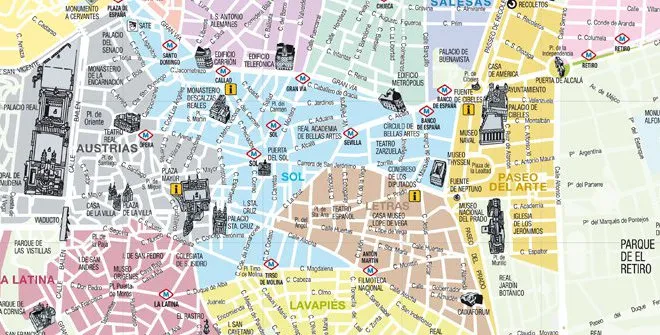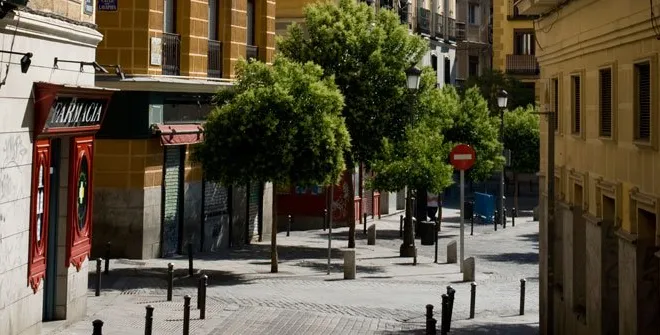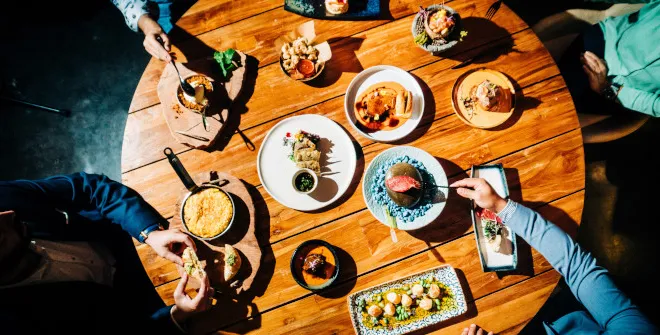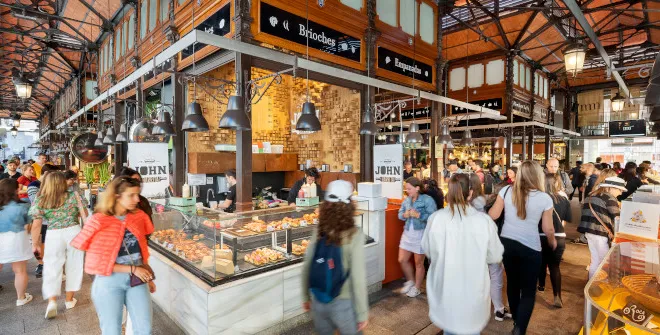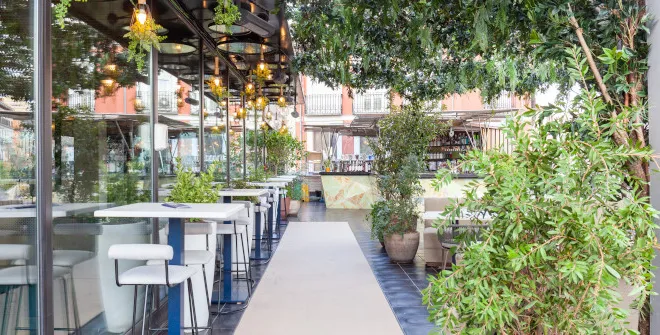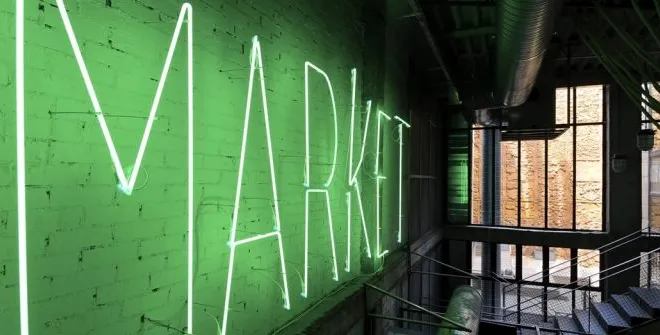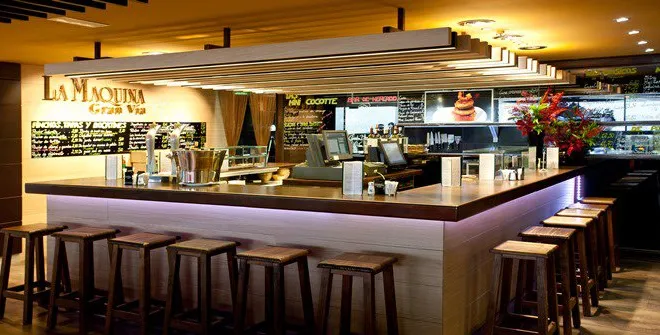Lavapiés
A melting pot of cultures and traditions, Lavapiés has never been stripped of its essence
The tourist district of Lavapiés lies in the southeast part of almond-shaped central Madrid. As in the neighbouring Barrio de La Latina, the streets here are steep, narrow and maze-like, which reminds us that the area emerged in the Middle Ages as a quarter outside the walled town soon after Madrid became the capital of the kingdom in 1561.
Since the sixteenth century, Lavapiés has been inhabited by the lower classes. Local residents used to live in apartment blocks, or tenements, called corralas that were arranged around an interior courtyard. You can see a typical example of this type of buildings at the corner of Tribulete and Mesón de Paredes.
Lavapiés is closely linked to the genuine, humorous, snappy character of Madrileños, which is well represented in many of the zarzuelas composed at the turn of the century, like Francisco Asenjo Barbieri’s El barberillo de Lavapiés. Madrid’s popular heritage lives in perfect harmony with the customs and traditions that accompanied immigrants coming from different countries who settled in the area, meeting place of a broad variety of cultures.
Getting to know Lavapiés (PDF) (4.6 MB)
In this cultural centre housed in a Neo-Mudéjar building, they run avant-garde performances, exhibitions, courses and workshops aimed at raising awareness of sustainable development, community solidarity, and other relevant social issues. With the arrival of the summer, its Terrace is transformed into the perfect place to have a drink, with an interesting programme including live music sessions on Sundays (Soundays) and open-air cinema on Saturdays.
Considered one of the crown jewels of Paseo del Arte (the Art Walk), it includes works by Dalí, Miró and Juan Gris that surround Picasso’s El Guernica. It is a fascinating tour through the contemporary Spanish art divided into three different itineraries. Jean Nouvel expanded the original Francisco Sabatini’s work, adding an auditorium, a library and new exhibition halls. The NuBel restaurant stands out with its elegant and colorful design offering an exquisite cuisine prepared with the best seasonal produce.
It is one of the two homes of Centro Dramático Nacional (National Drama Center) and it hosts half of its program, as well as the visiting international ensembles.
The classic Madrid-based circus has been recovered with a new location in the facilities of a former biscuit factory. This space, designed in 2002, houses concerts, exhibitions, workshops and all kinds of stage and circus performances, as well as its architecture benefits the acoustics for concerts.
The Spanish Film Archive concentrates on Spanish titles and preserves the national film heritage. It has a library and a screen in Cine Doré, a Modernist building in the Antón Martín Market.
Formerly home to the company Tabacalera Española, today it doubles as a community centre and an exhibition hall run by the Ministry of Culture.
Royal Monastery of Santa Isabel
A convent for Augustinian nuns leading cloistered lives and a girls-only school are housed in this seventeenth-century building decorated by Mariano Salvador Maella and Vicente Carducho, among other artists.
One of the landmarks of Lavapiés, it was built in the eighteenth century. Currently it hosts the UNED distance learning university.
Situated in Santa Isabel Street, close to the Atocha station, it was remodeled by Conde de Cervellón, making it one of the most outstanding residences in Madrid in the mid-19th century.
Lavapiés has a wide array of shops, mainly small, traditional ones, where you can get products imported to please the tastes of the immigrant populations.
Moreover, in the last decade, this neighbourhood has witnessed an interesting cultural development, attracting a great number of tourists. Around the Reina Sofía Museum (MNCARS) there are countless art galleries. Based on a variety of concepts and ideas, they’ve turned Lavapiés into an emerging focus of contemporary art. One of these galleries, on Calle del Doctor Fourquet, belongs to the renowned art collector Helga de Alvear.
Library-cafes, like La Libre or El dinosaurio todavía estaba allí, play a very important role in the new cultural renovation this neighborhood is going through. Most of them are specialized in one or another literary segment: comic books, philosophy, politics, classical literature… but what they all have in common is that they offer a delicious breakfast or snack to enjoy while you read.
Have you ever bought books by the pound? At the San Fernando Market you definitely can. The place features traditional food stalls too.
Another option is to visit the Antón Martín Market, another of the establishments that joins in today’s tendency of gourmet markets. Stalls with fresh produce and a wide variety of multi-cultural food (Spanish, Japanese, Italian, Mexican, Colombian, etc.).
One of the most charming shops of this area is Planthae, a botanical office where you can buy the most exotic flowers, but also enjoy an interesting exhibition and hand-made pottery. Here you will also find the Kling Flagship Store, a large, colourful space that offers the very latest fashions.
The open, multicultural character Lavapiés can boast of makes its food & drink department a well-appointed one. Would you like to savour exotic dishes from around the world? Indian, Chinese, Korean, Lebanese, Moroccan, Sub-Saharan, Latin American and Pakistani restaurants dot the dining scene of Lavapiés, so all you have to do is choose one of the multiple options and... bon appétit! Habibi (Lebanese) is one of the oldest in the neighbourhood.
Some of the greatest attractions of this neighborhood are the terraces and tapeo (going out for tapas). The streets and squares of Lavapiés offer an amazing setting for a complete tapas tour. Argumosa Street, with its El Económico bar, is one of the focal points for this, as well as Lavapiés square and the surrounding streets.
Tapapiés, the Multicultural Tapa and Music Route is held each year in Lavapiés, where traders and brands in the area participate with diverse culinary proposals for visitors. Different tapas in which cuisine from around the world merges with the tradition and freshness of Spanish gastronomy, accompanied by open-air concerts and other activities, such as exhibitions and poetry recitals. A route that also offers a vegan version with fully vegan and gluten free tapas.
You can also still find traditional wineries and bars that hark back to what life was like in the area 70 years ago, such as Bodegas Alfaro, Antonio Sánchez Tavern, La Taberna El Sur and Café Barbieri, decorated with all the charm of the traditional early 20th century cafés. Newer establishments include Los Chuchis, Los Porfiados, Juan Raro or La Casa Encendida coffee shop.
In the area, the Lebanese restaurant Beirut and the Galician restaurant O Pazo de Lugo, located in the lively Argumosa street, are also outstanding. And the restaurant La Nobia, which serves traditional dishes with a modern twist, proposing irreverent international and local cuisine.
Finally, in this part of Madrid there are vegetarian restaurants that cater well for vegans, since they omit all animal products and prepare meals with organic ingredients only.
This area is also a good option to have a coffee, with cafes such as Cafelito and Plántate. Pablo Caballero and Nolo Botana created Hola Coffee here, a new hip café very popular among coffee-lovers. You can find third-generation cafés with breakfast and snacks where their owners roast the coffee bought from small producers in Central and South America themselves. Also the cafeteria Pum Pum Bakery with the specialty coffee, bread and handmade croissants.
The cultural melting pot in Lavapiés also marks its leisure offer. You can dance a chotis at the traditional San Lorenzo party –which is held on 10th August in the surroundings of the parish of the same name – and enjoy festivities, such as Ramadan or the Festival of the Lamb –for the Muslim population–, or the Holi Festival –which announces the arrival of Spring in the Indian culture, filling the neighbourhood with colour, tolerance and integration between Madrid residents from different traditions and origins.
In the theatrical chapter, Lavapiés has written extensively. There are Teatro Valle Inclán, home of the National Drama Centre. Also, a handful of theatres putting on alternative performances can be found in the neighbourhood, some of them in quite peculiar locations.
The colourful and vibrant night scene in Lavapiés comes to life in small venues. Rock and indie pop, jazz, reggae and even flamenco are all comprised in the local soundtrack. Live music is available in many of the clubs here.
Sala Juglar, Traveler, Club 33 and Medias Puri – The Secret (open until 6am) should not be missed on your night out around this area.







